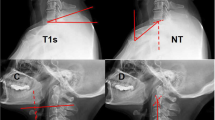Abstract
Purpose
To investigate the presence of head control deficits and its course of recovery after anterior cervical discectomy and fusion (ACDF) surgery in cervical spondylotic myelopathy (CSM) patients.
Methods
Thirty-seven CSM patients were assessed for their C2–C7 cervical lordosis, neck Range of Motion (ROM), repositioning accuracy, neck strength as well as surface electromyography of the neck muscle activities during slow head motions. Assessments were performed preoperatively and then at 3- and 6-month postoperatively.
Results
No significant difference was found for the C2–C7 cervical lordosis postoperatively at 6-month. ROM was restricted immediately after surgery but recovered over time, however, neck strength remained significantly reduced postoperatively. Reposition accuracy improved immediately after surgery but declined again at 6-month follow-up. In addition, muscle activities required to control head motions showed a continuous reduction postoperatively.
Conclusions
Adequate C2–C7 cervical lordosis was maintained in the current study with improvement of slow head motion control and ROM at 6-month. However, improvement in head position sense was not maintained and neck strength showed continuous declination overtime. Assessment and monitoring of head control deficits should be routinely considered in CSM patients.


Similar content being viewed by others
References
Salvi FJ, Jones JC, Weigert BJ (2006) The assessment of cervical myelopathy. Spine J 6:182S–189S. doi:10.1016/j.spinee.2006.05.006
Takayama H, Muratsu H, Doita M, Harada T, Yoshiya S, Kurosaka M (2005) Impaired joint proprioception in patients with cervical myelopathy. Spine 30:83–86 (Phila Pa 1976)
Andre-Deshays C, Revel M, Berthoz A (1991) Eye-head coupling in humans. II. Phasic components. Exp Brain Res Exp Hirnforsch 84:359–366
Lephart SM, Pincivero DM, Giraldo JL, Fu FH (1997) The role of proprioception in the management and rehabilitation of athletic injuries. Am J Sports Med 25:130–137
Proske U, Wise AK, Gregory JE (2000) The role of muscle receptors in the detection of movements. Prog Neurobiol 60:85–96
Ito T, Oyanagi K, Takahashi H, Takahashi HE, Ikuta F (1996) Cervical spondylotic myelopathy. Clinicopathologic study on the progression pattern and thin myelinated fibers of the lesions of seven patients examined during complete autopsy. Spine 21:827–833 (Phila Pa 1976)
Ross ED, Kirkpatrick JB, Lastimosa AC (1979) Position and vibration sensations: functions of the dorsal spinocerebellar tracts? Ann Neurol 5:171–176. doi:10.1002/ana.410050211
Holly LT, Dong Y, Albistegui-DuBois R, Marehbian J, Dobkin B (2007) Cortical reorganization in patients with cervical spondylotic myelopathy. J Neurosurg Spine 6:544–551. doi:10.3171/spi.2007.6.6.5
Takayama H, Muratsu H, Doita M, Harada T, Kurosaka M, Yoshiya S (2005) Proprioceptive recovery of patients with cervical myelopathy after surgical decompression. Spine 30:1039–1044 (Phila Pa 1976)
Fujibayashi S, Neo M, Yoshida M, Miyata M, Takemoto M, Nakamura T (2010) Neck muscle strength before and after cervical laminoplasty: relation to axial symptoms. J spinal Disord Tech 23:197–202. doi:10.1097/BSD.0b013e3181a1a73e
Ratliff JK, Cooper PR (2003) Cervical laminoplasty: a critical review. J Neurosurg 98:230–238
Sasai K, Saito T, Akagi S, Kato I, Ogawa R (2000) Cervical curvature after laminoplasty for spondylotic myelopathy–involvement of yellow ligament, semispinalis cervicis muscle, and nuchal ligament. J Spinal Disord 13:26–30
Malmstrom EM, Karlberg M, Melander A, Magnusson M (2003) Zebris versus Myrin: a comparative study between a three-dimensional ultrasound movement analysis and an inclinometer/compass method: intradevice reliability, concurrent validity, intertester comparison, intratester reliability, and intraindividual variability. Spine 28:E433–E440
Conley MS, Meyer RA, Bloomberg JJ, Feeback DL, Dudley GA (1995) Noninvasive analysis of human neck muscle function. Spine 20:2505–2512
Lee HY, Teng CC, Chai HM, Wang SF (2006) Test-retest reliability of cervicocephalic kinesthetic sensibility in three cardinal planes. Man Ther 11:61–68
Wu S, Ma C, Mai M, Li G (2010) Translation and validation study of Chinese versions of the neck disability index and the neck pain and disability scale. Spine 35:1575–1579. doi:10.1097/BRS.0b013e3181c6ea1b (Phila Pa 1976)
Duggal N, Rabin D, Bartha R, Barry RL, Gati JS, Kowalczyk I, Fink M (2010) Brain reorganization in patients with spinal cord compression evaluated using fMRI. Neurology 74:1048–1054. doi:10.1212/WNL.0b013e3181d6b0ea
Cheng CH, Wang JL, Lin JJ, Wang SF, Lin KH (2010) Position accuracy and electromyographic responses during head reposition in young adults with chronic neck pain. J Electromyogr Kinesiol 20:1014–1020. doi:10.1016/j.jelekin.2009.11.002
Lee PJ, Rogers EL, Granata KP (2006) Active trunk stiffness increases with co-contraction. J Electromyogr Kinesiol 16:51–57
Falla D, Rainoldi A, Merletti R, Jull G (2003) Myoelectric manifestations of sternocleidomastoid and anterior scalene muscle fatigue in chronic neck pain patients. Clin Neurophysiol 114:488–495
Granata KP, Marras WS (2000) Cost-benefit of muscle cocontraction in protecting against spinal instability. Spine 25:1398–1404
Revel M, Minguet M, Gregoy P, Vaillant J, Manuel JL (1994) Changes in cervicocephalic kinesthesia after a proprioceptive rehabilitation program in patients with neck pain: a randomized controlled study. Arch Phys Med Rehabil 75:895–899
Loudon JK, Ruhl M, Field E (1997) Ability to reproduce head position after whiplash injury. Spine 22:865–868
Kristjansson E, Dall’Alba P, Jull G (2003) A study of five cervicocephalic relocation tests in three different subject groups. Clin Rehabil 17:768–774
Emery SE (2015) Anterior approaches for cervical spondylotic myelopathy: which? When? How? Eur Spine J 24(Suppl 2):150–159. doi:10.1007/s00586-015-3784-6
Acknowledgments
This study was supported by research grants from the Ministry of Science and Technology, Taiwan (101-2221-E-002-060-MY3), and the Healthy Aging Research Center, Chang Gung University, Taiwan (EMRPD1D0291 and CMRPD1B0332). None of the authors have any personal or institutional financial interest in drugs, materials, or devices described in this manuscript submission.
Author information
Authors and Affiliations
Corresponding author
Ethics declarations
Conflict of interest
The authors declare that they have no potential conflict of interest.
Rights and permissions
About this article
Cite this article
Cheng, CH., Chien, A., Hsu, WL. et al. Identification of head control deficits following anterior cervical discectomy and fusion in patients with cervical spondylotic myelopathy. Eur Spine J 25, 1855–1860 (2016). https://doi.org/10.1007/s00586-015-4368-1
Received:
Revised:
Accepted:
Published:
Issue Date:
DOI: https://doi.org/10.1007/s00586-015-4368-1




